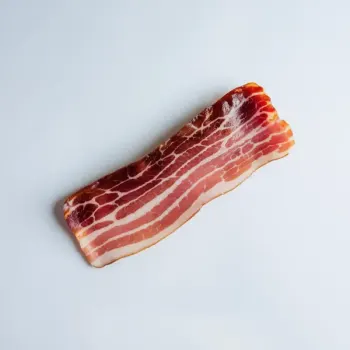Guanciale and bacon are both pork products used in cooking, with guanciale being an Italian cured meat from pork jowl and bacon a salt-cured pork from belly or back cuts. They differ in flavor, texture, and usage in traditional and contemporary dishes.

Guanciale is an Italian cured meat product prepared from pork jowl or cheeks. Its name is derived from 'guancia,' the Italian word for 'cheek.' Rich in fat and distinct in flavor, guanciale is seasoned and cured for several weeks to develop its unique taste.

Bacon is a type of salt-cured pork made from various cuts, typically from the pork belly or from back cuts, which have less fat than the belly. It is eaten on its own, as a side dish (particularly in breakfasts), or used as a minor ingredient to flavor dishes.
Guanciale is known for its rich fat content and delicate pork flavor, which is enhanced through the curing process. It has a soft texture and melts easily when cooked, which adds a depth of flavor to dishes. On the other hand, bacon has a smokier taste and a firmer texture, due to the different curing and smoking processes it undergoes. Bacon is also more prevalent and versatile in various cuisines, whereas guanciale is a staple in specific Italian dishes.

Your ultimate Recipe Box, Meal Planner, and Cooking Class all in one
Guanciale is the traditional ingredient in classic Italian pasta dishes like 'Pasta all'Amatriciana' and 'Spaghetti alla Carbonara.' It provides a rich and robust flavor to these dishes. When using guanciale, expect a silky texture from the rendered fat, which is key to achieving the authentic taste of these pastas. The guanciale should be cooked slowly to render out the fat without becoming too crispy. While not traditional, bacon is sometimes used as a substitute in Italian pasta dishes for its smoky flavor. It can be found in recipes like 'Bacon Mac and Cheese' or 'Bacon and Egg Pasta.' When using bacon, expect a smokier taste and a slightly crispier texture. Bacon should be cooked to the desired level of crispiness for these recipes, keeping in mind that it won't render as much fat as guanciale.
In traditional Italian cuisine, guanciale is utilized in 'Saltimbocca,' a dish where it's layered with veal and sage. It provides a subtle pork flavor without overpowering the delicate veal. Guanciale is also used in 'Sugo all’amatriciana,' where its fat is key to the sauce's richness. While not authentic, bacon can be used in Italian-inspired dishes such as 'Bacon Bruschetta' or 'Bacon Risotto.' It adds a familiar smoky taste and a crispy texture that can be appealing to those who prefer a more pronounced pork flavor.
Chefs may use guanciale in contemporary dishes like 'Pork Belly Bites' as a twist on the classic, adding a more Italian flair with its unique flavor. It is also featured in 'Guanciale Wrapped Asparagus' where its fat beautifully complements the vegetables when roasted. Bacon's versatility shines in modern cooking, finding its way into 'Bacon-Wrapped Dates,' 'Bacon Jam,' and even 'Bacon Ice Cream.' Its smoky flavor profile and crispy texture make it a favorite for inventive recipes that require a punch of umami and crunch.
Guanciale is higher in fat, and bacon often contains added preservatives.
| Nutrient | Bacon ( per Ounce ) | Guanciale ( per Ounce ) |
|---|---|---|
| Fat | 12g | 10g |
| Sodium | N/A | N/A |
| Calcium | N/A | N/A |
| Protein | 9g | 7g |
| Calories | 150 | 120 |
| Carbohydrates | 0g | 0g |
Bacon can be used as a substitute for guanciale in Carbonara, but the dish will have a smokier flavor and lack the traditional richness that guanciale provides.
No, guanciale is not smoked; it is cured with spices and salt, which gives it a different flavor profile from smoked bacon.
Guanciale typically has a higher fat content compared to bacon, which contributes to its rich flavor and texture.
While bacon can be used as a substitute in many dishes, it may not be suitable in recipes where the unique flavor and fat content of guanciale are essential, such as in traditional Italian dishes like 'Pasta all'Amatriciana.'
Guanciale is made from the pork jowl or cheeks, which is different from the belly or back cuts typically used for bacon.